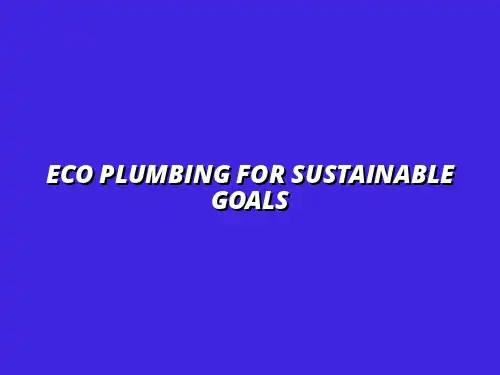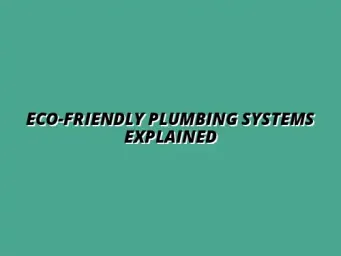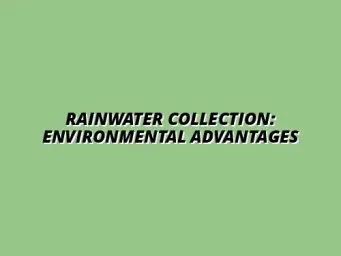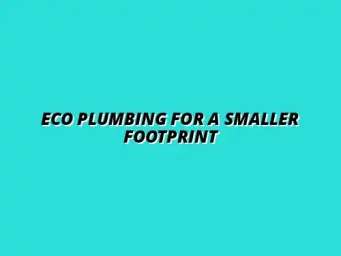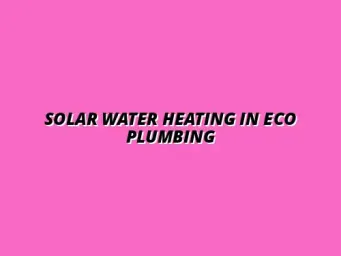Understanding Eco Plumbing and Its Role in Sustainability
Eco plumbing is not just a trend; it’s a necessary shift towards more sustainable living. This practice focuses on minimizing the environmental impact of our plumbing systems while maximizing efficiency and conservation. By implementing eco-friendly solutions, we can save water, reduce energy consumption, and promote a greener future! For homeowners looking to make their homes more sustainable, exploring eco-friendly plumbing options is a great starting point.
Incorporating eco plumbing into our everyday lives is crucial for building a more sustainable society. It involves a variety of practices that aim to utilize resources more responsibly. Understanding the core principles of eco plumbing is the first step towards making a positive impact on our planet.
Defining Eco Plumbing: Key Principles and Practices
At its core, eco plumbing integrates sustainable practices into traditional plumbing systems. This includes using water-saving fixtures and materials that reduce water waste. It also seeks to lower energy consumption through efficient heating systems and renewable energy sources. Regular annual plumbing maintenance is also key to ensuring your systems run efficiently and last longer.
Some of the key principles of eco plumbing include the following:
- Water conservation: Using fixtures and systems that minimize water usage.
- Energy efficiency: Implementing technologies that reduce energy consumption.
- Non-toxic materials: Choosing eco-friendly materials that are safe for the environment.
- Waste reduction: Designing systems to minimize waste and promote recycling.
What Sets Eco Plumbing Apart from Traditional Plumbing?
One major difference between eco plumbing and traditional plumbing lies in their approach to resources. Traditional plumbing often prioritizes convenience over conservation, leading to higher water and energy usage. In contrast, eco plumbing emphasizes sustainability and seeks to balance functionality with environmental responsibility.
By focusing on long-term sustainability, eco plumbing solutions can lead to significant cost savings for homeowners and businesses alike. Moreover, eco plumbing often utilizes advanced technologies that enhance the performance of plumbing systems while being gentle on the environment. Learn more about conserving water in your bathroom with these helpful water-saving tips.
Core Concepts of Sustainable Plumbing Solutions
To fully embrace eco plumbing, it’s important to understand its core concepts. These concepts guide the implementation of sustainable plumbing practices effectively. Here are some essential elements:
- Rainwater harvesting: Collecting and reusing rainwater for irrigation and other non-potable uses.
- Greywater recycling: Reusing water from sinks and showers for irrigation or flushing toilets.
- Low-flow fixtures: Installing showers, faucets, and toilets designed to use less water.
- Solar water heating: Utilizing solar energy to heat water, reducing reliance on fossil fuels.
The Importance of Eco Plumbing in Environmental Conservation
Eco plumbing plays a significant role in conserving our planet’s resources. It helps mitigate the effects of climate change by reducing the overall demand for water and energy. By adopting eco plumbing practices, we can help preserve ecosystems and ensure a sustainable future for generations to come! And remember, proper water heater maintenance is crucial for efficiency and longevity.
These practices not only benefit the environment but also contribute to economic savings. For instance, lower water bills and reduced energy costs can quickly add up, making eco plumbing a wise financial choice.
How Eco Plumbing Reduces Water Consumption
Water scarcity is a growing concern worldwide. Eco plumbing addresses this issue by promoting water-efficient fixtures and systems. By incorporating low-flow toilets, faucets, and showerheads, households can significantly cut their water usage. Discover more ways to save water in your home and reduce your impact.
Some effective ways eco plumbing reduces water consumption include:
- Installing dual-flush toilets: These toilets allow users to choose between a full or partial flush, conserving water with every use.
- Using low-flow showerheads: These devices limit the water flow while maintaining pressure, providing a satisfying shower experience.
- Catching and reusing rainwater: Rain barrels can collect water for landscaping and gardening, reducing the need for treated water.
Minimizing Carbon Footprint Through Green Plumbing Technologies
Another major benefit of eco plumbing is its potential to reduce our carbon footprint. By utilizing green plumbing technologies, we can lower greenhouse gas emissions associated with conventional plumbing systems. For example, solar water heating systems harness renewable energy, minimizing reliance on fossil fuels. Learn more about sustainable plumbing practices to minimize waste.
To effectively minimize carbon footprints, consider these technologies:
- Energy-efficient water heaters: These heaters use less electricity or gas, leading to lower emissions.
- Smart irrigation systems: These systems monitor moisture levels and deliver water only when necessary, preventing waste.
- Insulated pipes: Insulating hot water pipes reduces heat loss, enhancing energy efficiency.
By embracing eco plumbing, we can all contribute to creating a healthier planet while also enjoying the benefits of reduced utility costs.
Navigating Challenges and Opportunities in Eco Plumbing
Eco plumbing offers a way to significantly contribute to sustainability, but it also comes with its own set of challenges. Understanding these challenges is important for anyone looking to integrate eco-friendly practices into their plumbing. By identifying obstacles, we can better prepare to tackle them while also recognizing the opportunities that eco plumbing can present. For Birmingham residents, finding a reliable plumber is important; consider checking out plumbers in Tyseley, Birmingham.
Regulatory frameworks play a major role in shaping how eco plumbing is adopted. These frameworks can either support or hinder the implementation of green plumbing practices. Knowing the local codes and regulations can help navigate the landscape more effectively, making it easier to align with sustainability goals.
Regulatory Frameworks Supporting Eco Plumbing Initiatives
Every region has its own set of rules and regulations that dictate how plumbing systems should be developed and maintained. This is where understanding local codes becomes crucial. Many cities and states encourage eco plumbing through specific guidelines aimed at promoting sustainable practices. These regulations can include:
- Water efficiency standards for fixtures and appliances
- Requirements for rainwater harvesting systems
- Regulations promoting the use of recycled water
By staying informed about these codes, homeowners and businesses can ensure compliance while also benefiting from the advantages of eco plumbing. Furthermore, many local governments offer incentives that can ease the financial burden associated with upgrading plumbing systems.
Understanding Local Codes and Regulations for Sustainable Plumbing
Local codes often focus on ensuring public health and safety, but they can also promote environmental sustainability. It’s important to research the specific plumbing codes in your area. Understanding these can help in choosing the right eco plumbing solutions for your project. Key aspects to focus on include:
- Permits and approvals required for installations
- Standards for water-saving fixtures
- Guidelines for rainwater and greywater systems
By grasping these regulations, you can better navigate the installation process and take full advantage of eco plumbing benefits. This knowledge sets the stage for making informed decisions that align with both sustainability and legal requirements.
Incentives and Grants for Eco Plumbing Adoption
Many governments and organizations provide financial incentives to encourage the adoption of eco plumbing practices. These incentives can significantly lower the cost of installation or upgrades. Some of the most common types of support include:
- Tax rebates for energy-efficient plumbing fixtures
- Grants or low-interest loans for water conservation projects
- Subsidies for using renewable energy sources in plumbing
Taking advantage of these financial incentives can make eco plumbing solutions more accessible, benefiting both the environment and your wallet. It’s worth researching what programs are available in your area and how you can apply for them!
Frequently Asked Questions About Eco Plumbing
As eco plumbing continues to grow in popularity, so do the questions surrounding its impact and effectiveness. Addressing these common queries is crucial for individuals and businesses considering this approach. Let’s explore some frequently asked questions about eco plumbing.
How Does Eco Plumbing Influence Property Values?
Investing in eco plumbing can have a positive effect on property values. Many homebuyers are increasingly seeking energy-efficient and environmentally friendly homes. Some factors to consider include:
- Lower utility bills due to reduced water usage
- Potential property tax incentives
- Enhanced market appeal to eco-conscious buyers
By integrating eco plumbing, you can not only contribute to sustainability but also improve your property's value, making it a win-win situation!
What Are the Most Effective Eco Plumbing Products on the Market?
Choosing the right products can make a huge difference in the effectiveness of your eco plumbing system. Some highly recommended eco plumbing products include:
- Low-flow faucets and showerheads
- Dual-flush toilets
- Rainwater harvesting systems
- Greywater recycling systems
These products can significantly reduce water consumption while maintaining functionality. It's essential to research and select products that fit your specific needs and align with your sustainability goals!
Future Trends in Eco Plumbing and Sustainability
The landscape of eco plumbing is evolving, with many exciting trends emerging. Innovations in technology and practices are driving forward the sustainability agenda. Understanding these trends is essential for both homeowners and businesses looking to stay ahead in eco plumbing.

